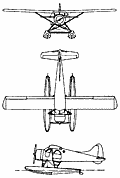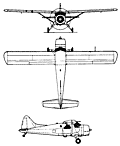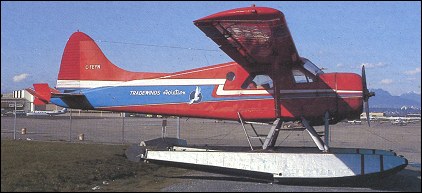|
| Design of the de Havilland DHC-2
Beaver light transport was started in Toronto during late 1946. The concept behind this first of de Havilland Canada's line of effective STOL transports was influenced by the specific requirements of the Ontario Department of Lands and Forests. The resulting aircraft also suited the exacting requirements of 'bush' pilots in North America and elsewhere for an effective, rugged and reliable STOL utility transport.
The prototype was flown for the first time on 16 August 1947, and the type was certificated in Canada during March 1948. Large-scale production had already begun, and the Beaver I was soon in service, powered by the Pratt & Whitney R-985 radial. Of the 1,657 Beaver Is built, no fewer than 980 went to the US forces (YL-20 service test, L-20A and L-20B production aircraft, redesignated U-6 in 1962) and 46 to the British Army. There followed a single Beaver II with the Alvis Leonides radial and, in 1964, a few 10-passenger Turbo-Beaver III powered by the 431kW United Aircraft of Canada Ltd (later Pratt & Whitney Aircraft of Canada) PT6A-6 or -20 turboprop. Most of the Turbo-Beavers were used by civil operators. In New Zealand one Beaver had an AiResearch TPE331 turboprop engine installed. Production ended in the mid-1960s as de Havilland Canada concentrated on the development of more ambitious projects and products.
At the height of its career, the Beaver was to be found in some 50 countries, where it won universal acclaim for performance, ground stability conferred by wide-track tailwheel landing gear, and versatility. Basic accommodation was provided for a pilot and seven passengers, the latter replaceable by up to 680kg of freight. Great flexibility was bestowed on the Beaver by its ability to operate on wheel, ski, float or amphibious float landing gears.
Airtech Canada of Peterborough, Ontario, has converted a number of Beavers to take the 447kW Polish PZL-3S seven-cylinder air-cooled radial piston engine driving a PZL four-bladed propeller.
 | A three-view drawing (592 x 877) |
| MODEL | DHC-2 Beaver I |
| ENGINE | 1 x Pratt & Whitney R-985 Wasp Junior radial piston engine, 336kW |
| WEIGHTS |
| Take-off weight | 2313 kg | 5099 lb |
| Empty weight | 1293 kg | 2851 lb |
| DIMENSIONS |
| Wingspan | 14.63 m | 48 ft 0 in |
| Length | 9.22 m | 30 ft 3 in |
| Height | 2.74 m | 9 ft 0 in |
| Wing area | 23.23 m2 | 250.05 sq ft |
| PERFORMANCE |
| Max. speed | 262 km/h | 163 mph |
| Cruise speed | 230 km/h | 143 mph |
| Ceiling | 5485 m | 18000 ft |
| Range | 1180 km | 733 miles |
 | A three-view drawing (844 x 1028) |
| lxbfYeaa, e-mail, 15.11.2025 15:04 20 reply | | lxbfYeaa, e-mail, 07.11.2025 03:04 20 reply | | ubaTaeCJ, e-mail, 21.02.2025 19:31 20 reply | | GrahamClayton, e-mail, 25.11.2023 05:53 Unusual design of the horizontal stabilisers. reply | |
| | EUGENIO GALLARDO, e-mail, 15.08.2022 21:45 EN CHILE NO HEMOS TENIDO NUNCA ESTE TIPO DE AVION DESEO SABER SI EXISTE ALGUNO DISPONIBLE A LA VENTA,
ESPERO NOTICIAS-
GRACIAS- reply | | Tony Hugman, e-mail, 26.10.2020 02:37 I flew Beavers, north pacific coast, Pr Rupert, Kechican, Al, Queen Charlottes.6 yrs..also, Polish Bvr, 2...3 years north Sask...I have the record for overloads..
.9 outboard engines, plus fuel, plus fish guide, in a single trip..
.it,l outperform the Canadian beaver 6 to 1 reply |
| Rob, e-mail, 20.08.2017 20:23 Beaver 2 is in Saskatchewan and is privately owned and flown regularly, I know the owner well. reply | | Keith Chiazzari, e-mail, 04.08.2015 23:19 I flew Beavers on floats for Alert Bay Air Service, Trans-Provincial Airlines based in Prince Rupert, and finally for West Coast Air in Vancouver for a number of years. What an amazing aircraft, it could carry just about any load, internally and externally. When the visibility was poor it could fly at a very slow speed and turn on a dime if the conditions became impossible. It could land in very choppy waters and withstand a strong crosswind. I will always miss flying her! reply | | john bowen, e-mail, 24.04.2015 20:26 I flew the beaver at clark field in 1952 and loved how easy it was doing take off and landing, when u put down the flaps it reacted like being in a parachute, and and greatest soft landing possible..taking 6 passengers we had to drain some gas tanks,,but comfortable with 4 passengers ,,loved it.. reply |
| Fred Brown, e-mail, 01.02.2015 03:39 I was crew chief on the L-20 Beaver #18787 with the 24th Division's air section at Lanier Field near Sendai, Japan in 1952 and 1953. It was brand new and replaced my L-20.
Great machine, built like a tank, worked like a truck and flew like a Super Cub. Later heard that it went missing on a trip to Korea. reply | | Doug Constantine, e-mail, 01.02.2015 01:53 I accidently stumbled on to this sight. It really got me laughing out loud. I was a USAF pilot-forward air controller-air liaison officer. I have a couple thousand hours in B-52D,F and Hs. In 1968 I was sent to RVN as an O-2A FAC. A bunch of us were diverted to the Korean DMZ shortly after the Pueblo was captured. I was really disappointed but when you have lemons make lemonade. Most of us set up house at Camp Casey where at that time the 7th Division was housed. I became the ROK 25th division ALO. The Air Force had no planes to fly and we were given jeeps with about 6 different frequencies to cover. We were told to call in air strikes if the North sent tanks down the well used invasion route. Soon we became good friends with the commander of the 7th Aviation Battalion. He had a couple of Beavers and a Cessna O-1. We spent more than a few nights at the Aviation Officers club drinking with the good colonel. He liked us and as he had no fixed wing pilots offered to check us out in his fixed wings planes, and teach to fly his H-13s. We started logging a lot of time and I particularly liked the Beaver and started ferrying generals and politicians along the DMZ. This went on for about 6 months when the USAF found out and had a conniption. They sent up a Major to talk to us and check us out. I remember the flight well as he was very concerned that I could navigate along the DMV without flying into North Korea and causing an incident. He apparently decided I was qualified and he spotted a very short dirt strip in the mouth of an old volcano. He asked me to do a full flap landing there. I asked if he was sure and he said yes. So I pumped the flaps down, mind you, I had never down a full flap landing as it just wasn't necessary. So I gauged that I was going to come down like and elevator and we did. Just prior to touchdown I pulled the nose up a little and applied power at we made contact. It was a perfect three point landing and I swear to God that we must have rolled all of about 5 plane lengths. I was amazed. I looked at him, and in total innocence asked him how I did. He said fine. I inquired a little more, very gently, and asked him compared to others how did I do? He smiled at me and said he had never seen anybody do a full flap landing in a Beaver before. This is a true story. We had a lot of fun with the Beaver and we did a lot of very strange things with it. I agree with all the prior remarks, and although this was only the second tail dragger I had flown, I never had an issues landing the plane. One time we had flown down to Osan AFB on a 3000' overcast day and turned final behind a C-130. The tower called us with the mandatory beware of wake turbulence. I was flying in the left seat with a good buddy who was a Major. I told John that there is no wind so I will carry 6 or 7 knots more on final. As we passed over the threshold we got caught in the wake turbulence and it rolled us upside down, such that I could see the guys in the F-4 that was number 1 looking up at us. John yelled at me "Jesus Doug" and slammed the rudder pedal which I already had hit the firewall. I kept the power stable and released the back pressure and we rolled up right, make a closed pattern and landed. As we did we had forgotten that we had taken John's enlisted radio operator with us and he was "clearing" for us. He took a beating bouncing around the cabin. We went immediately to the O club for a drink. Yep, the Beaver was tough. reply | | J.L.Jones, e-mail, 17.01.2015 17:40 My uncle Henry was a test pilot and salesperson for DH Canada reply |
| Willie, e-mail, 14.06.2014 17:35 I'll add a little note to this as I spent 3 years at Downsview right at the peak of the Beaver and Otter Prime Manifacturing span I was in the adjacent hanger working on Vampire Jets and Harvard aircraft my trade was Aero Engine and I was certified on P /W radial engines Single Row R-985 and R-1340 s as well as R /R Goblin Turbines and GE J47s used in the Sabre I Have flown quite a few hrs in the Beaver as well as the Otter when they were doing experimental work on them They had a test pilot and if I remember correctly his last name was GIVENS e /x Rcaf Pilot We used to be appalled when foreign People would come and they would demo the beaver and the Otter it was hard to believe the stall speed of those aircraft as the demo would include a nose in the wind and flap down and reduce the engine speed till the aircraft would literally stand still I still have the Pratt & W engine overhaul and specs manuals in my possession same manual applied to both engines I'm 80 now and I still look back at what an achievement they were able to get without the aid of computers just good brain work reply | | ted ward, e-mail, 01.05.2013 18:47 attached to 130 flight air tech, barrie davis was a sgt pilot,
and was a gentleman. anyone remember earnie johnson. happy days, great bunch of blokes reply |
|
| | ted ward, e-mail, 11.03.2013 19:10 worked on beavers while in the forces, magic plane,magic places,magic people.magic times. reply |
| Vit L, e-mail, 08.12.2012 23:56 Hello. Give answer to the question please. Where to find detailed drawings of the Beaver?? reply | | Bob B, e-mail, 06.06.2012 23:23 I have been flying A Beaver commercially on the BC coast for 25 years. Although the practice is now rightfully frowned upon, I can verify from personnal experience that it can be flown off the water with water over the top of the floats almost to the rear spredder bar. I have taken off on floats with 25 kt+ 90 degree xwinds. And done a lot of things the Beaver is not supposed to do. reply | | Bob Cadman, e-mail, 17.02.2012 05:01 I flew "Beavers" in Vietnam from 1968-70 as a log support bird for Birddog companies. It was a great plane to fly out of 800 ft. dirt strips. reply | | Ian L. McQueen, e-mail, 13.02.2012 17:14 I've only seen a Beaver in the Canadian national air museum in Ottawa, but I do have a story from a pilot who flew them. I met Bud Voss, now deceased, through model airplanes. He bought a kit from me of the 8-foot span model made by Unionville Hobby of Markham, Ontario. Bud told me that as part of their military training they had to "land" a Beaver in a minimal distance. He did it in 13 feet! It was essentially a crash landing and the plane had to be rebuilt afterward, but that was standard procedure as part of their training.
Anyway, that's what he told me and there is no way to question him about it. He had no reason to lie about it.
IanM reply |
| Curt Bryan, e-mail, 12.02.2012 00:05 To Bob Pedigo comment...18.09.2010. No wonder you didn't like the 20k xwind component you were working with. I remember the Beaver as having a 10k xwind component, and at times wished it were rated at 20 or even 30. That plane had a way of making you look good in the worst of conditions.
I am grateful to have had so many hours in it. reply |
|
Do you have any comments?
|
| 
COMPANY
PROFILE
All the World's Rotorcraft
|








 john bowen
john bowen
20
reply